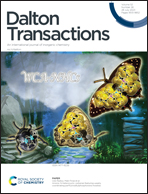Kink distortion of the pseudo-S4 axis in pseudotetrahedral [N2O2] bis-chelate cobalt(ii) single-ion magnets leads to increased magnetic anisotropy†
Abstract
Two new mononuclear cobalt(II) complexes with the general formula [Co(L1,2)2] (1 and 2) were synthesized using bidentate Schiff base ligands with NO donor set, namely, 2-(benzothiazole-2-ylimino)methyl-5-(diethylamino)phenol (HL1) and its methyl substituted derivative 2-(6-methylbenzothiazole-2-ylimino)methyl-5-(diethylamino)phenol (HL2). X-ray structure analysis reveals a distorted pseudotetrahedral coordination sphere at the cobalt(II) ion, that cannot be described by a simple twisting of the two ligand chelate planes with respect to each other, which would imply a rotation about the pseudo-S4 axis of the complex. Such a pseudo-rotation axis would approximately be colinear with the two vectors defined by the cobalt ion and the two centroids of the chelate ligands, where the angle κ between the two vectors would be 180° in an ideal pseudotetrahedral arrangement. For complexes 1 and 2, the observed distortion can be characterized by a significant bending at the cobalt ion with angles κ of 163.2° and 167.4°, respectively. Magnetic susceptibility and FD-FT THz-EPR measurements together with ab initio calculations reveal an easy-axis type of anisotropy for both complexes 1 and 2, with a spin-reversal barrier of 58.9 and 60.5 cm−1, respectively. For both compounds, frequency-dependent ac susceptibility measurements show an out-of-phase susceptibility under applied static fields of 40 and 100 mT, which can be analyzed in terms of Orbach and Raman processes within the observed temperature range.
![Graphical abstract: Kink distortion of the pseudo-S4 axis in pseudotetrahedral [N2O2] bis-chelate cobalt(ii) single-ion magnets leads to increased magnetic anisotropy](/en/Image/Get?imageInfo.ImageType=GA&imageInfo.ImageIdentifier.ManuscriptID=D3DT01604H&imageInfo.ImageIdentifier.Year=2023)


 Please wait while we load your content...
Please wait while we load your content...